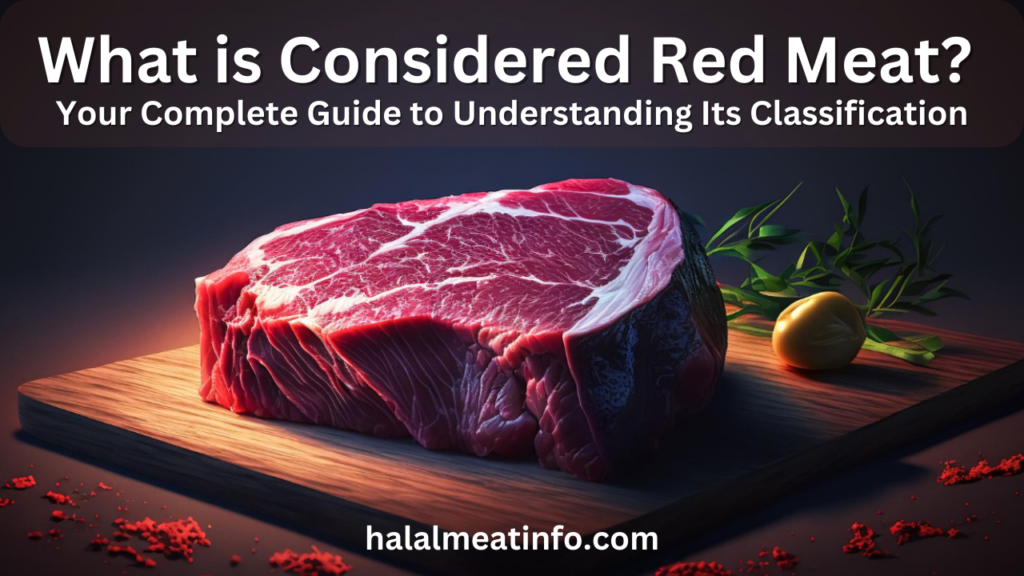What is Considered Red Meat? A Comprehensive Breakdown
When you hear the term “Red Meat”, what comes to mind? For most, images of succulent steaks, hearty beef stews, or a juicy hamburger might flash across their mental palates. Indeed, red meat is a staple in many diets worldwide, celebrated for its rich flavor and ample nutritional offerings. Have you ever taken a moment to consider the specific components that make up red meat? In this post, we dive into the world of red meat, exploring its definition, variations, and why it holds such a prominent place in global cuisine.

Introduction
Exploring the realm of animal-based proteins is essential to gain a comprehensive understanding of red meat. These proteins are mainly extracted from the muscles of different animals, such as cattle and sheep. However, the term “red meat” is not just a reference to the color of the meat, but it also relates to the high levels of a protein known as myoglobin found within these particular meats. So, join us as we embark on this journey of exploration into red meats, dispelling myths and shedding light on the facts.
Understanding Red Meat
In the culinary world, red meat is often classified under the ‘protein foods’ umbrella due to its high protein content. However, the classification of red meat goes beyond mentioning protein. It encompasses a broad spectrum of biological classifications and examples, giving it its unique identity.
Biological Classification
The biological classification of red meat is primarily based on the animal species from which it is derived. Mammals, especially those used in agriculture, are the primary source of red meat. However, certain birds and fish species with darker flesh are also considered red meat due to the higher levels of myoglobin in their muscles. This protein, myoglobin, is key in determining the ‘redness’ of meat, as it is responsible for carrying oxygen in muscle cells, leading to a distinctively darker hue.
Types of Red Meat
Beef
Beef, derived from cattle, is one of the most common types of red meat consumed worldwide. It includes various cuts like steak, roast, ground beef, and ribs.
Lamb
Lamb, the meat from young sheep less than a year old, is considered red meat, especially popular in some regions. It includes cuts like leg of lamb, lamb chops, and ground lamb.
Veal
Veal is the meat from young calves and is considered a type of red meat. It’s known for its tender texture and delicate flavor.
Goat
Goat meat, also known as chevon or mutton in some cultures, is a type of red meat that’s less commonly consumed in some regions but is a staple in others. It’s often used in curries and stews.
Venison
Venison, the meat of deer, is a red meat popular in certain regions, particularly among those who hunt. It’s known for its lean, richly flavored meat and considered a types of red meat.
Bison
Bison meat, originating from large, grazing mammals, is a type of red meat renowned for its lean, slightly sweet flavor. It’s a less common choice in mainstream cuisine but is popular among those seeking a healthier alternative to beef due to its lower fat and cholesterol content.
Nutritional Value of Red Meat
Red meat has been woven into the fabric of our diets, largely due to its high nutritional value. It is abundant in proteins, vitamins, and minerals that are crucial for promoting overall well-being. However, it’s crucial to understand the specifics of these nutrients, how our bodies process them, and the potential health implications of consuming red meat.
Proteins and Essential Amino Acids
Red meat is a substantial and valuable source of high-quality protein, containing all nine essential amino acids vital for the human body [1]. These amino acids are the building blocks of proteins, playing a crucial role in cell growth and repair, muscle building, and overall bodily functions.
Vitamins and Minerals
Red meat is rich in several vitamins and minerals. It’s particularly high in Vitamin B12, a critical nutrient that supports the nervous system and aids in producing DNA and red blood cells [2]. Red meat is also an excellent source of iron, especially heme iron, which is easily absorbed by the body compared to non-heme iron found in plant foods [3]. Furthermore, it contains a good amount of zinc, selenium, and other nutrients that contribute to various aspects of health.
Potential Health Implications
While red meat is nutritionally dense, it’s essential to consider its potential health implications. Certain studies indicate a possible association between excessive red meat consumption and a higher risk of heart disease, specific types of cancer, and other health concerns [4]. Therefore, it’s crucial to consume red meat as part of a balanced diet and in moderation.
Red Meat vs. White Meat
The comparison between red and white meat is a common topic in nutritional discussions, each with their distinctive characteristics, benefits, and potential drawbacks.
Defining White Meat
White meat refers to poultry and fish with lighter-colored flesh compared to red meat. This is due to the lower myoglobin levels in the animals’ muscles. Examples include chicken, turkey, and certain fish like cod, haddock, and tilapia. The ‘whiteness’ of meat can also change with cooking; for instance, chicken breasts tend to become whiter after being cooked.
Defining Red Meat
Red meat refers to meat with a darker color due to higher myoglobin levels in the muscles. Beef, lamb, and pork are common examples of red meat. These meats are rich in iron, zinc, and B-vitamins. Cooking methods can affect the color; red meat tends to darken when cooked. Enjoying a variety of meats can provide a diverse range of nutrients for a balanced diet.
Nutritional Differences
While both red and white meat are excellent sources of protein, there are noticeable differences in their nutritional profiles. White meat, particularly fish, is often lauded for its high omega-3 fatty acid content, which is essential for heart health. Poultry is also generally lower in saturated fat compared to red meat. Conversely, red meat tends to be higher in iron, specifically heme iron and Vitamin B12.
Health Implications
Numerous studies have weighed in on the health implications of both red and white meat. It’s commonly suggested that substituting red meat with white meat can lower the risk of heart disease due to the lower saturated fat content. However, it’s important to note that preparation methods—like grilling or frying—can influence the health impact of both kinds of meat. As with red meat, moderation, and balance are key when incorporating white meat into one’s diet.
Taste and Culinary Uses
There’s also a distinct difference in taste between red and white meat, which can influence their culinary uses. Red meat is often described as more robust and flavorful, while white meat has a milder, more delicate flavor. This makes white meat a versatile choice in various dishes, from salads to stir-fries, while red meat often stars in hearty, comfort food classics.
Health Aspects of Consuming Red Meat
Consuming red meat brings along its share of health aspects that can swing the pendulum either way. Let’s delve deeper into the benefits and risks associated with its consumption.
Benefits of Red Meat
Red meat can be an important part of a balanced diet when consumed in moderation. It is a rich source of high-quality protein, which aids in rebuilding cells and tissues in the body [1]. Red meat also provides essential nutrients like vitamin B12, zinc, and iron [2]. Vitamin B12 plays a crucial role in the production of red blood cells and the functioning of nerve cells, while iron promotes hemoglobin production. Zinc is important for immunity, protein synthesis, and cell division [2]. Red meat is also a source of creatine and carnosine, vital nutrients for muscle and brain health [5].
Risks Associated with Red Meat Consumption
Although red meat has numerous benefits, it also carries potential health risks, particularly when consumed excessively. High levels of red meat consumption have been associated with increased risks of heart disease, colorectal cancer, and type 2 diabetes [4]. This is often attributed to its high saturated fat content and the presence of compounds formed during processing or cooking at high temperatures [6]. Moreover, processed red meats (like sausages, hot dogs, and bacon) are often high in sodium and nitrates, which could further amplify these health risks [7]. Hence, moderation is key when incorporating red meat into a balanced diet.
Red Meat in Different Diets
Incorporating red meat into one’s diet varies depending on dietary preferences, health considerations, and cultural factors. For instance, in a typical Western diet, red meat is a staple, often consumed in the form of steaks, burgers, or roasts. Conversely, diets centered around plant-based foods, like vegetarian or vegan diets, completely exclude red meat. However, substitutes such as plant-based ‘meat’ products provide alternatives that mimic the taste and texture of red meat. In Mediterranean diets, red meat is consumed moderately, with a focus on lean cuts, while the Paleo diet encourages consumption of grass-fed red meat, as it’s thought to align closer with the dietary habits of our ancient ancestors. Lastly, in low-carb or ketogenic diets, red meat is often a primary source of protein and fat. Regardless of dietary approach, it’s essential to consider the nutritional content and health implications when incorporating red meat into a diet.
Red Meat and Personal Dietary Choices
When it comes to dietary choices, red meat can be a controversial topic, mainly because its consumption is often viewed in black-and-white terms – it’s either considered beneficial or detrimental. However, the reality is more nuanced. The decision to incorporate red meat into one’s diet should ideally be based on individual health goals, dietary preferences, and ethical considerations. While some people might choose to exclude red meat due to environmental, ethical, or health reasons, others may include it as part of a well-rounded diet due to its high nutrient content. Personal dietary choices often lie on a spectrum, with vegetarianism, veganism, flexitarianism, and omnivorism being common dietary patterns. Whichever dietary pattern one follows, it is vital to prioritize variety, balance, and moderation for optimal health.
Red Meat Alternatives
Plant-Based Meats
With the rise of vegetarianism and veganism, there has been a surge in the development of plant-based meat substitutes. These alternatives, such as Beyond Meat and Impossible Foods, are designed to mimic red meat’s taste, texture, and nutritional profile, offering an animal-free option for those who still crave the experience of eating meat.
Clink to read completely in depth about Plant-based Meat alternatives.
Legumes and Pulses
Legumes and pulses, such as beans, lentils, chickpeas, and peas, serve as a fantastic substitute for red meat. They are high in protein and fiber, while also offering a range of other essential nutrients like iron and zinc. Their versatility in cooking also allows them to be used in a variety of dishes, from stews and curries to salads and burgers.
Poultry and Fish
For those still wishing to consume animal protein, white meat options like poultry and fish can serve as a healthy substitute for red meat. They are generally leaner, lower in saturated fats, and, in the case of fish, provide beneficial omega-3 fatty acids.
Tofu and Tempeh
Soy-based products like tofu and tempeh offer a viable alternative to red meat. They are rich in protein and offer a unique texture that can be adapted to numerous cooking methods and recipes. These options are particularly popular in Asian cuisine.
Seitan
Seitan, a product made from gluten, the protein in wheat, is another popular meat substitute. Its meaty texture has earned it the nickname “wheat meat.” Seitan is high in protein and can serve as a substitute for red meat in various recipes. However, individuals with gluten intolerance or celiac disease should avoid it.
Addressing Misconceptions about Red Meat
Misconception 1: All Red Meat is Unhealthy
There is a widespread misconception that all red meat is detrimental to health. However, the health implications of red meat largely vary based on the type and cut of the meat, along with the cooking techniques employed. Lean cuts of red meat, such as sirloin or tenderloin, have lower fat content and can be part of a balanced diet. Additionally, cooking methods that don’t involve high temperatures or excessive oil can help maintain the nutritional benefits of red meat.
Misconception 2: Red Meat Causes Cancer
While some studies suggest a link between red meat consumption and increased cancer risk, particularly colorectal cancer, it’s important to note that these findings often relate to processed red meats and diets high in red meat. Consuming red meat in moderation and within the context of a varied diet rich in fruits, vegetables, and whole grains, does not conclusively lead to an increased risk of cancer.
Misconception 3: Red Meat is Bad for the Environment
The production of red meat can exert a notable environmental footprint, contributing to greenhouse gas emissions and deforestation. However, sustainability practices in meat production are evolving. For instance, regenerative agriculture practices aim to raise livestock in a manner that enhances the ecosystem, demonstrating that it’s feasible to produce red meat sustainably.
Misconception 4: Red Meat is High in Cholesterol
While red meat does contain cholesterol, it’s not as high as often believed. Furthermore, dietary cholesterol doesn’t affect blood cholesterol levels as much as the type of fats you consume. Lean cuts of red meat can be a part of a heart-healthy diet when consumed in moderation.
Misconception 5: Avoiding Red Meat is the Only Way to Improve Your Diet
Excluding red meat from your diet is not the sole approach to attaining a healthy diet. Balanced nutrition involves more than just cutting out certain food groups. Equally vital is to concentrate on including a diverse range of nutrient-rich foods in your diet, such as fruits, vegetables, whole grains, and lean protein sources.
FAQ’s
Red meat is the term used for meat sourced from mammals, including beef, lamb, veal and other animals.
No, chicken is not considered red meat. It falls under the category of white meat along with turkey and other poultry.
The red color in red meat is primarily due to the presence of myoglobin, a protein that stores oxygen in muscle tissues. Due to its red colour it is also considered red meat.
Yes, processed meats such as sausages, bacon, and ham, which are derived from red meats like pork or beef, are also categorized as red meat.
Yes, red meat is a good source of essential nutrients like protein, iron, zinc, and vitamin B12, but it should be consumed in moderation due to its higher saturated fat content.
Certain studies indicate that consuming excessive red and processed meats might be linked to certain health risks. It’s recommended to balance red meat consumption with other protein sources and adopt a varied and balanced diet.
Conclusion
Deciding whether to include red meat in your diet involves careful consideration of multiple factors, such as personal health goals, dietary preferences, and ethical beliefs. While red meat can provide valuable nutrients, alternatives like plant-based meats, legumes, pulses, poultry, fish, and soy products offer a spectrum of choices for those seeking other options. Misconceptions about red meat abound, but it’s crucial to rely on scientific findings and individual nutritional needs when shaping dietary habits. In the end, a balanced and varied diet, inclusive of nutrient-dense foods from multiple food groups, is the cornerstone of good health. Whether red meat forms part of that balance is a decision that should be tailored to your individual needs and circumstances.
References:
- Hoffman JR, Falvo MJ, (2004). Protein – Which is Best? Link
- National Institute of Health. Vitamin B12 fact sheet. Link
- Thomas Ems; Kayla St Lucia; Martin R. Huecker (2023). Biochemistry, Iron Absorption Link
- Micha R, Wallace SK, Mozaffarian D. (2010). Red and processed meat consumption and risk of incident coronary heart disease, stroke, and diabetes mellitus: a systematic review and meta-analysis. Link
- Wu G, (2020). Important roles of dietary taurine, creatine, carnosine, anserine and 4-hydroxyproline in human nutrition and health. Link.
- Chai W, Morimoto Y, Cooney RV, et al. (2017). Dietary Red and Processed Meats Intake and Markers of Adiposity and Inflammation: The Multiethnic Cohort Study. Link
- Micha R, Wallace SK, Mozaffarian D, (2010). Red and processed meats consumption and risk of incident coronary heart disease, stroke, and diabetes mellitus: a systematic review and meta-analysis. Link






